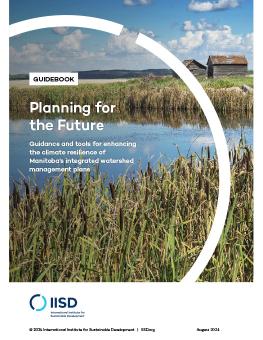
Planning for the Future
Guidance and tools for enhancing the climate resilience of Manitoba's integrated watershed management plans
A guidebook to help watershed planners, water planning authorities, and project management teams tasked with leading the development and update of integrated watershed management plans (IWMP).
Manitobans are experiencing warmer temperatures, severe wildfires, changing precipitation patterns, and more frequent floods and droughts. Without adaptation planning, watershed residents face greater risk to their property, livelihoods, and mental and physical health.
Watershed districts must consider how to incorporate climate adaptation in their management plans and programs to maintain the health of the watershed and the delivery of ecological, economic, and social benefits that residents enjoy and rely upon, all while facing an uncertain future.
In Manitoba there are 27 integrated watershed management planning areas, all responsible for water-related issues, water management programs, and finding a balance between ecosystem, community, and economic health. Each produces an integrated watershed management plan (IWMP) to act as a guiding document, which are periodically reviewed and updated. With the renewals, there is a great opportunity to incorporate more climate adaptation planning entry points in the process.
The guidebook is structured to incorporate climate adaptation planning into the existing IWMP processes by identifying entry points at different stages of the IWMP process.
This guidebook includes
- ways to help assess how anticipated impacts of climate change will affect the watershed and identify actions that will reduce the risk and severity of these impacts;
- ways to increase knowledge about climate change risks within watersheds and suggest how to build capacity to manage these risks;
- suggestions on how to ensure that investments in watersheds are appropriate to the changing climate in the long term;
- an easy-to-follow guide for using the Climate Atlas of Canada for accessing and interpreting climate data;
- five worksheets to help with adaptation planning; and
- an extensive list of helpful resources.
You might also be interested in
COP 29 Outcome Moves Needle on Finance
In the last hours of negotiations, concerted pressure from the most vulnerable developing countries resulted in an improved outcome on the finance target, with a decision to set a goal of at least USD 300 billion per year by 2035 for developing countries to advance their climate action.
December 2024 | Carbon Minefields Oil and Gas Exploration Monitor
In November 2024, 23 oil and gas exploration licences were awarded across five countries, with Russia granting the licences that account for the largest portion of embodied emissions.
Increased Support Needed to Achieve India's Clean Energy Goals
India is on track to achieve many of its 2030 clean energy goals but needs to step up government support measures to accelerate the deployment of offshore wind, electric vehicles, and green hydrogen, according to a new report.
The Role of Multilateral Development Banks for Low-Carbon Procurement in the Infrastructure Sector
This report examines the critical role of multilateral development banks (MDBs) in advancing low-carbon procurement within the infrastructure sector.